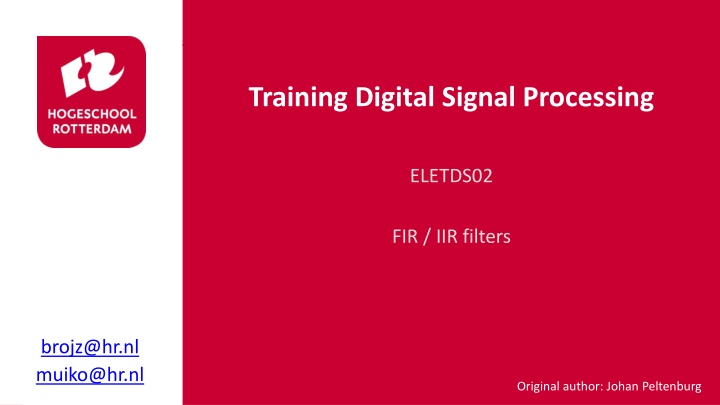
Digital Signal Processing: FIR and IIR Filters
Explore the world of digital signal processing with a focus on FIR and IIR filters. Learn how signals are processed digitally, the role of Fourier transforms, and the implementation of filters to manipulate signal frequencies effectively.
Download Presentation

Please find below an Image/Link to download the presentation.
The content on the website is provided AS IS for your information and personal use only. It may not be sold, licensed, or shared on other websites without obtaining consent from the author. If you encounter any issues during the download, it is possible that the publisher has removed the file from their server.
You are allowed to download the files provided on this website for personal or commercial use, subject to the condition that they are used lawfully. All files are the property of their respective owners.
The content on the website is provided AS IS for your information and personal use only. It may not be sold, licensed, or shared on other websites without obtaining consent from the author.
E N D
Presentation Transcript
Training Digital Signal Processing ELETDS02 FIR / IIR filters brojz@hr.nl muiko@hr.nl Original author: Johan Peltenburg
2 weeks ago Signals in real life are continuous and analog. Need to sample them to be able to process them digitally. They become discrete-time digital signals. Signals can be represented as sines/cosines with certain frequencies. Many problems are specified or solved in the Fourier frequency domain. We can switch between time and frequency domain with the Fourier Transform. 2
Last week Filters remove certain frequencies from a signal. Filters have a transfer function often specified in the frequency domain. We can implement the filter in the discrete-time domain by using the IDTFT (Inverse Discrete Time Fourier Transform). (Discrete-time) filters have several characteristic such as response shape (LP, HP, BP, BS), cut-off frequency and others. 3
TDS02 FIR FILTERS AND WINDOWS 4
FIR Filter Last week we obtained a general formula for an FIR filter: ? ? ? = ?? ?[? ?] = ? ?[?] ?=0 Vector with samples ?[? ?] to ?[?]. Vector with coefficients ?0to ??. How to get the coefficients? 5
FIR filter coefficients Many methods: Window Design Method (via IDTFT) Frequency Sampling (also involves IDTFT) Weighted Least Squares Method (need statistics :-( ) Some other methods Fourier transform H(z) t f Inverse Fourier transform 6
filterDesigner(1) MATLAB can apply the IDTFT for us. (It can also do many other methods) Use filterDesigner: Set relevant parameters. Click Design Filter ... 7
filterDesigner (2) Resulting magnitude response is shown: A wild sidelobe appears! But wait... 8
Windowing (1) 1 The IDTFT is as follows: 2??? ? ??2??????? ? ? = ? 1 2?? But... ? . (n can be any integer) We have an infinite number of coefficients that represents our filter in time. :-( To implement a filter in practice , we need to have a finite number of coefficients. The filter order specifies how many coefficients we use: ? ? ? = ?? ?[? ?] = ? ?[?] ?=0 (For an N-th order FIR filter we need N samples.) 9
Windowing (2) Windowing is limiting the number of coefficients (to the desired filter order) in a certain way. For example with a rectangular This would go on to infinity window: Windowed filter: We adjust the filter in time, what is the effect in frequency? 10
Windowing (3) A rectangular window is not the only window: Rectangular We can let the coefficients at the edges go to zero more smoothly: Different effect on frequency! Hamming 11
Windowing (4) LP filter with rectangular window: What did we gain? What did we lose? Same filter with Hamming window: 12
TDS02 IIR FILTERS 13
IIR filters FIR is a non-recursive filter (no feedback). Discrete-Time filters with feedback exist: ? ? ? ? = ?? ? ? ? ?? ? ? ? ?=0 ?=1 We call them Infinite Impulse Response filters (why?). The filter is some kind of difference equation. We have a special frequency domain for this called the Z-domain. It is very closely related to the Fourier frequency domain. 14
Even more transforms IIR filters are much more effective with the same number of calculations (coefficients). However, because they contain feedback, the output can become unstable. They are often designed by looking at their well studied continuous-time equivalents. Continuous- time domain x(t) Discrete-time domain x[n] Sampling Inverse Z transform Laplace transform Inverse Laplace transform Z transform Laplace- domain (frequency) X(s) Bilinear Transform Forward/Backward Euler Etc... Z-domain (frequency) X(z) 15
IIR in filterDesigner filterDesigner does the math. (A simple example is given in the lab handbook if you re interested.) 16
Comparison of FIR and IIR (1) FIR: Fc 5thorder Fc = 2.4 kHz Magnitude (dB) -3 dB IIR (Butterworth): 5thorder Fc = 2.4 kHz Magnitude (dB) -15 dB 17
Comparison of FIR and IIR (2) FIR (Hamming window): Fc = 2.4 kHz 20thorder Magnitude Roughly the same number of calculations IIR (Butterworth): Fc = 2.4 kHz 10thorder Magnitude 18
IIR filter structures For IIR filters different implementation structures exist (see lab handbook). Simplest form (Direct Form I): ? ? Addition (watch the signs!) ? ? = ?? ? ? ? ?? ? ? ? ?=0 ?=1 Multiplication Delay of 1 ?? 19
Summary The IDTFT gives us an infinite number of coefficients of our FIR filter. To implement the filter in practice we need to apply windowing. Rectangular windowing might introduce unwanted effects in the frequency domain. Different window formulas exist that try to keep certain unwanted effects to a minimum. (Experiment with these!) IIR filters contain feedback (or are recursive). With only a few coefficients good results can be achieved . Might be unstable. 20

